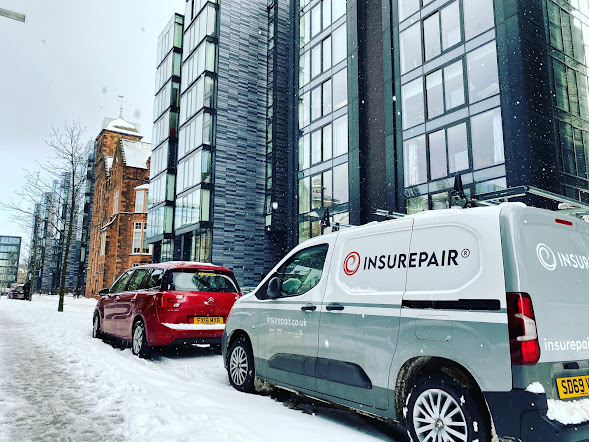DON’T LET HEAVY SNOW DAMAGE YOUR HOME | INSUREPAIR ® insurepair.co.uk
How to protect your property from the weight of snow A little bit of snow can create picturesque scenes — but a lot of it can cause problems, including the risk of roofs collapsing in extreme cases. Knowing the warning signs and what action you can take will help you protect your property. How much does snow weigh? Although snow weight varies depending on whether it is fresh or compacted, Local Authority Building Control, which represents all local authority building control teams in England and Wales, gives the following example: "Snow has about 1/10th the density of liquid water, and so 1l of water weighs 1kg. So 300mm of snow would weigh 30kg/m². "If this lands on a 24m2 lightweight conservatory roof then this is an additional 720kg load to the roof. The average adult weighs 75 kg, so that's equivalent to almost 10 people sitting on the roof!" Damage is most often caused where large amounts of snow collects after falling gradually over a number of days. It is typically the weight of this compacted snow which has the potential to cause roofs on conservatories, outbuildings or even houses to collapse. What type of properties are at risk from snow weight Homes which are in exposed, rural locations, at higher altitudes or in regions which generally have higher snowfall rates (such as Scotland and eastern England), are more likely to be affected by the impact of heavy snowfall. Roofs with significant overhanging edges can be at a higher risk of damage from excessively heavy coverings of snow and ice, as can large span or low-pitched roofs. Where a building is alongside a taller one, there is the risk that accumulated snow could fall onto the lower building adding to the existing weight of settled snow or causing immediate damage through the sudden impact. Staggered roof lines, parapets and other features which create uneven aspects to a roof can create a barrier which allows snowdrifts to build up and create additional stresses in those areas. How to prevent damage from heavy snow You should ensure your gutters and drainpipes are well maintained and kept clear of debris to allow melting snow to drain away from your roofs. Also, make sure you repair or replace any damaged or missing slates or tiles. Once snow is falling, you can attempt to prevent damage by warming the building or rooms in order to melt the snow from the roof — for example, opening a loft hatch or heating a conservatory or porch can melt the snow. Just make sure nobody stands underneath an area where snow could fall off in large amounts. For low buildings, it may be possible to rake the snow from the roof to lessen the weight, but only if it is safe to do so, and if you have another person around to help you. Listen for unusual sounds Creaking type sounds could indicate distress on your property and you should contact your insurance company or seek professional advice. Roofs of outbuildings, barns and conservatories may not be as strong as your main building — look out for bowing or unusual creaking noises, and stay out of those areas as much as possible. Check your roof void If your property has no underfelt below the tiles or slates it's possible that snow could build up inside and cause damage to the loft and ceilings below. Always make sure to have someone else present if checking the loft — if you suspect any wiring or electrical sockets have become wet then don't touch them. Turn off the electricity supply at the fuse box and call for assistance from a professional electrician. Review your cover Check your Home Insurance policy to see if you would be covered if damage from snow weight or melting snow were to occur. Get in touch if you need us. INSUREPAIR | We Care Telephone: 0131 478 3391 Email: info@insurepair.co.uk Website: insurepair.co.uk | |
 | |
| |
INSUREPAIR ® based in Edinburgh successfully carries out, Insurance Repairs, Renovations and Property Maintenance throughout Central Scotland. INSUREPAIR ® are Approved & Accredited by Major Insurance Companies, Loss Adjusters, Building Repair Networks & Property Managers. | |


